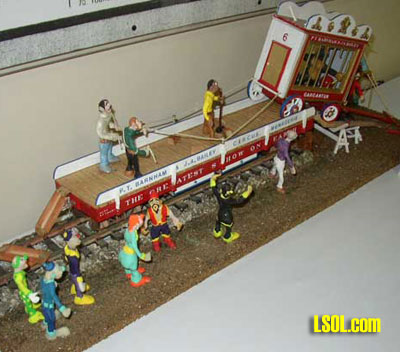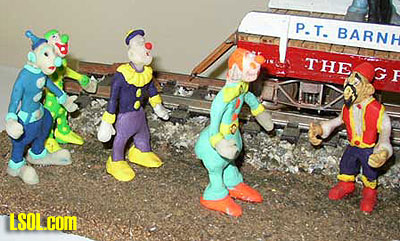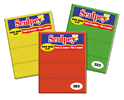Scratch & Bash
:
How-to's
Building with Polymer Clay - Part 1
Sep 26, 2007


By Jeanne DeVoto |
Author
Bio
Polymer clay is, as the name implies, a pliable, blendable polymer compound for artists and crafters. Read this mulit-part article and learn all about this great product and how you can use it on your railroad.
|
What is polymer clay? Polymer clay is, as the name implies, a pliable, blendable polymer compound for artists and crafters. It's not a true clay - clay is fine particles of silicate suspended in water, whereas polymer clay is fine particles of polyvinyl chloride (PVC) suspended in plasticizer - but it can be used much like clay. What makes polymer clay special is its versatility. It comes in dozens of colors, and you can blend clays together like paints to make your own colors. Since the color is inherent in the particles, you can also work two or more colors together without blending them, if you prefer, for special effects such as caneworking and marbling. The clay's pliability and ductility let you use techniques from glasswork, textile arts, and sculpture. And polymer clay doesn't dry out, so you can sculpt and form it without worrying about a time limit. 
Firing - the process that fuses the particles into a solid - requires only low temperatures, low enough to use a home oven as your kiln. The colors and size are not changed during firing. When fired, the clay gets hard enough to make durable objects, and can be finished in various ways to obtain textures from glassy to stonelike.
What can I use polymer clay for? In Large Scale Trains you can use polymer clay to make just about anything; people, car loads, and any kind of small accessory that you might find on a railroad. You can cover anything (as long as it won't melt or burn at the low firing temperatures) with a veneer of polymer clay: wooden boxes, picture frames, mirrors, tableware. One popular application is jewelry: polymer clay can be used to make beads, pendants, bracelets, and neckpieces. Small sculptures and buttons are other possibilities. Clay artists have developed techniques to give polymer clay the appearance of granite, jade, amber, coral, turquoise, and ivory, and its flexibility means you can make pieces in shapes and sizes that wouldn't be possible using actual stone. (Because the plasticizer in polymer clay may leach out even after it's fired, polymer clay is not suitable for objects in direct contact with food.) Where can I find the clay? Polymer clay is undergoing a surge in popularity and is more widely available than it was a few years ago. Look in local craft stores, art-supply stores, and bead stores. Some toy stores and general (sundries) stores also carry polymer clay, although the selection of colors is sometimes limited. You can obtain polymer clay via mail order, although some outlets require you to buy in large quantities and/or have a reseller's license. There are several polymer clay manufacturers; each brand is a little different in softness, strength, and so on, and each one offers its own selection of colors. Polymer clay is generally available in small (about 2 oz.) and large (about 12 oz.) packages. In the U.S., a 2-oz. package usually costs between $1.50 and $3.00, depending on brand and location. 
Do I need special equipment? All you need to create polymer clay pieces is your hands and an oven. Clay artists use various kinds of equipment to make working with the clay easier and to create special effects for some pieces, but these are not really necessary. However, there are some implements that are useful to the beginner: Work surface The raw clay may damage some surfaces (plastic and wood), so you need to work with it on some surface, such as a piece of smooth glass or marble. You can also tape a sheet of waxed paper to a table top and put the clay on the waxed paper - if the paper gets dirty, you can just remove it and use a new sheet. Piercing tool If you want to hole for stringing. You can make this hole with a long sewing needle or a wooden skewer. Knife A knife is useful to cut the clay. It can be a cheap, unserrated kitchen knife (but don't use the same knife for both food and clay). Many other things can be used with clay, but these are good tools for the beginner. You can find or buy more equipment as you need it. What brand of polymer clay should I use?   There's no one answer to this question; each clay brand has its own strengths and weaknesses, and different clay artists have different preferences. Some of the available brands are: Sculpey Polyform Products Co. There are three types of Sculpey: The original Sculpey comes only in white, in 2-lb boxes. It is a soft clay, very brittle and chalky when fired, and is the least expensive of the clays. Super Sculpey comes only in flesh-tone in 1-lb boxes. It's stronger and more flexible when fired than original Sculpey, sometimes used for doll-making. Sculpey III is most often used by clay artists. It comes in about 40 colors in 2-oz packages, and is usually easy to find. Sculpey III is the softest and easiest to condition of the commonly available clays; however, it gets softer the more it's worked, and easily smears when used in canes. (You can work around this problem by chilling your Sculpey canes before slicing them.) Sculpey III develops a slightly porous, matte finish after firing, which looks especially good with dark colors, but does not buff to as high a shine as finer-grained clays and is not as strong when fired. The colors are strong and may overwhelm colors in other clays when mixed; if you're mixing Sculpey III with another clay brand, start with small amounts of the Sculpey III and watch the color. The light colors seem to be mixed with white and can be a little dull. This clay comes in about 30 colors, including translucent, brights, metallics, and fluorescents.
Premo Sculpey Polyform Products Co. This replacement for Promat is the newest of the clays. This brand is fairly soft and easy to condition, but holds detail in canes well. The colors are drawn from a "painter's palette" of warm and cool blues, yellows, and reds, so those with a background in color theory will find it easier to mix custom colors to their own specifications. Premo was developed by the Clay Factory, and earlier versions were known as Clay Factory Clay (CFC). Fimo Eberhard Faber Fimo is a widely-available polymer clay and probably the most popular among clay artists, although you may not be able to find all of the colors locally. Fimo comes in 58g (about 2 ounces) and 350g (about 12.5 ounces) packages. It is the stiffest of the clays and the most difficult to condition. Fimo's firmness lets it hold very fine detail in canework; smearing is rare. When fired, Fimo has a slightly glossy, "plasticky"-looking surface. It buffs well and develops a high shine. Fired Fimo is very strong. Fimo has a very beautiful selection of colors, including two transparent clays, six "stone" textured clays, a glow-in-the-dark, and metallics ("perlglantz"). There is also a soft formulation of Fimo that comes in a different selection of colors. Promat Polyform Products Co. Promat is made by the same company as Sculpey. Promat differs from Sculpey in being firmer in texture - harder to condition, but less prone to smearing, stronger when fired, and flexible in thin sheets. Promat has a relatively limited selection of colors, including excellent pearlescent colors. This brand is being phased out by Polyform as Premo is introduced. Friendly Clay Amaco Available in packages and as pre-made canes, ready for slicing. Amaco also sells glazes, metallic powders, and molds for use with polymer clay. The best brand for you will depend on what you want to use it for, and also on your personal preferences and how you like to work with with the clay. Some of the clays are available in sample packs that let you try several colors in small amounts. You can also mix different brands of clay to get the level of softness, color, and other qualities you want.
| Building With polymer Clay |
| I have wanted to make some special figures for my railroad and was wondering what to use. Now I know. I enjoyed reading your segment on using polymer clays and will be looking forward to your next installment. Great work Jeanne Regards.....Dave |
| Dave Clarke - 08/26/2007 - 03:56 |
Top of Page
|



